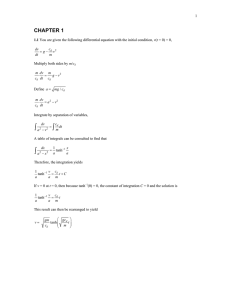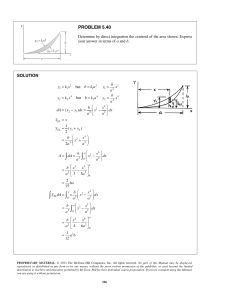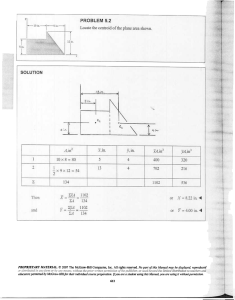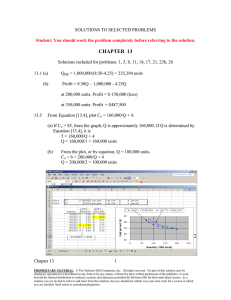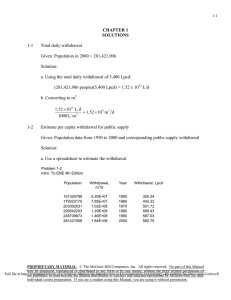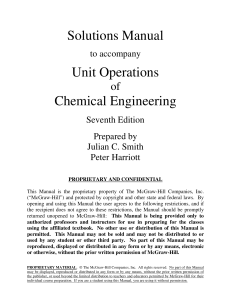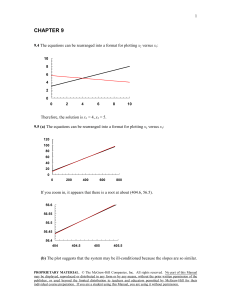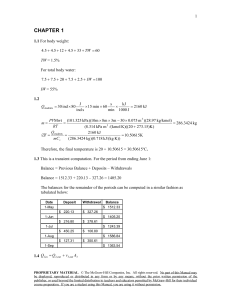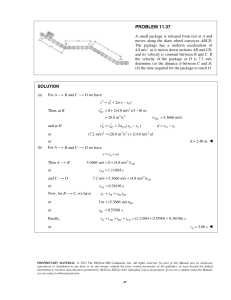PROBLEM 9.31
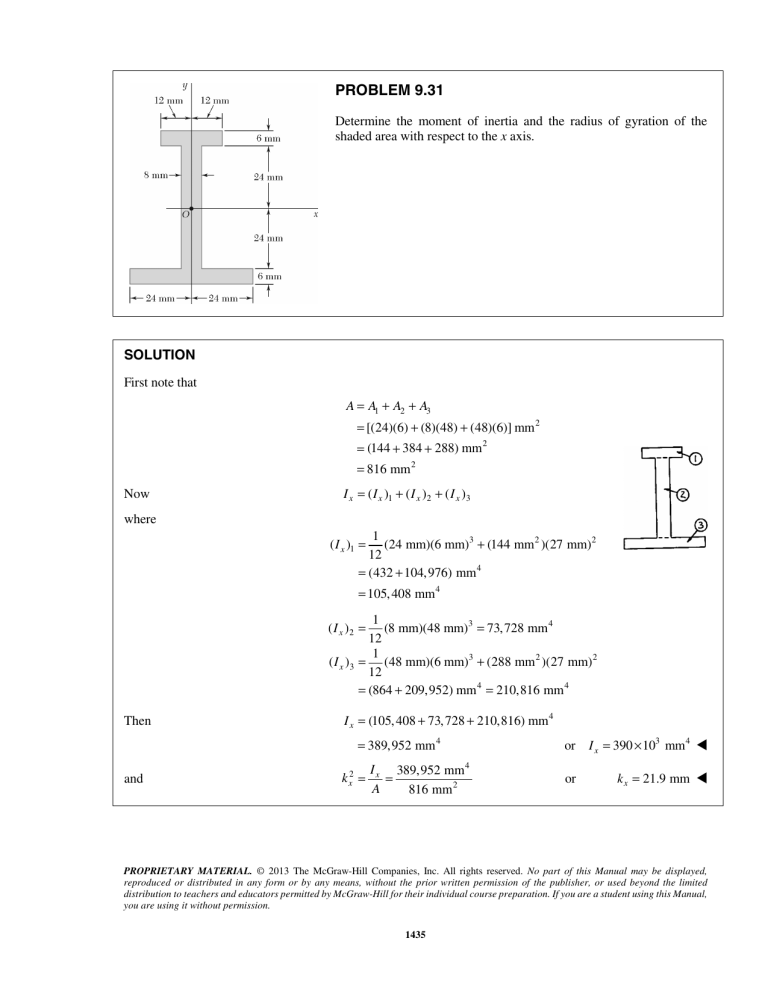
PROBLEM 9.31
Determine the moment of inertia and the radius of gyration of the shaded area with respect to the x axis.
Now where
SOLUTION
First note that
Then and
I x
=
1
+ A
2
+ A
3
=
=
= 816 mm 2
= I
1
+ I
2
+ I
3
2
I x
=
= 389,952 mm 4 k 2 x
=
I x
A
=
389,952 mm 4
816 mm 2
2
( )
1
=
1
12
=
(24 mm)(6 mm) 3 + (144 mm )(27 mm) 2
4
= 105, 408 mm 4
I
3
2
=
=
1
12
1
12
=
(8 mm)(48 mm) 3 = 73,728 mm 4
(48 mm)(6 mm) 3 + (288 mm )(27 mm) 2
+ 4 = 210,816 mm 4
4 or or
I x
= 390 10 mm k x
= 21.9 mm
4
PROPRIETARY MATERIAL.
© 2013 The McGraw-Hill Companies, Inc. All rights reserved. No part of this Manual may be displayed, reproduced or distributed in any form or by any means, without the prior written permission of the publisher, or used beyond the limited distribution to teachers and educators permitted by McGraw-Hill for their individual course preparation. If you are a student using this Manual, you are using it without permission.
1435
Eq. (1):
SOLUTION
PROBLEM 9.39
Determine the shaded area and its moment of inertia with respect to the centroidal axis parallel to AA ′ , knowing that d that the moments of inertia with respect to and 6.9 × 10 6 mm 4 , respectively.
1
= 30 mm and d
AA ′ and BB ′
2
= 10 mm, and
are 4.1 × 10 6 mm 4
I
AA ′
= ×
I
BB ′
= ×
4
4
= + A (30 mm) 2
= + A (40 mm) 2
I
BB ′
− I
AA ′
= (6.9 4.1) 10 6 = A (40 2 − 30 )
× 6 = A (700)
4.1 10 6
I (4000)(30) 2
(1)
A = 4000 mm 2
I = 500 10 mm 4
PROPRIETARY MATERIAL.
© 2013 The McGraw-Hill Companies, Inc. All rights reserved. No part of this Manual may be displayed, reproduced or distributed in any form or by any means, without the prior written permission of the publisher, or used beyond the limited distribution to teachers and educators permitted by McGraw-Hill for their individual course preparation. If you are a student using this Manual, you are using it without permission.
1444
PROBLEM 9.41
Determine the moments of inertia respect to centroidal axes respectively parallel and perpendicular to side AB .
I x
and I y
of the area shown with
SOLUTION
First locate centroid C of the area.
Symmetry implies Y = 30 mm.
Dimensions in mm
A , mm 2 x , mm xA , mm 3
1
2
1
2
72 36 = − 1296
5184
54
46
349,920
–59,616
Σ 290,304
Then X A = Σ xA : X = 3 or
Now where
X = 56.0 mm
I x
= I
1
− I
2
I
1
=
1
12
(108 mm)(60 mm) 3 = ×
I
2
= 2
1
36
(72 mm)(18 mm) 3 +
1
2
×
=
4
+ 4 = × 4
[( )
2
is obtained by dividing A
2 into ]
Then I x
= − × 4 or I x
=
2
4
PROPRIETARY MATERIAL.
© 2013 The McGraw-Hill Companies, Inc. All rights reserved. No part of this Manual may be displayed, reproduced or distributed in any form or by any means, without the prior written permission of the publisher, or used beyond the limited distribution to teachers and educators permitted by McGraw-Hill for their individual course preparation. If you are a student using this Manual, you are using it without permission.
1446
Also where
Then
PROBLEM 9.41 (Continued)
I y
= I
1
− I
2
( )
1
=
1
12
=
(60 mm)(108 mm) 3 + (6480 mm )[(56.54) mm] 2
+ 4 = × 4
I
2
=
=
1
36
(36 mm)(72 mm) 3 + −
+ 4 = × 4
I y
= − 4
2 or I y
= 4
PROPRIETARY MATERIAL.
© 2013 The McGraw-Hill Companies, Inc. All rights reserved. No part of this Manual may be displayed, reproduced or distributed in any form or by any means, without the prior written permission of the publisher, or used beyond the limited distribution to teachers and educators permitted by McGraw-Hill for their individual course preparation. If you are a student using this Manual, you are using it without permission.
1447
PROBLEM 9.43
Determine the moments of inertia I x
and I y
of the area shown with respect to centroidal axes respectively parallel and perpendicular to side AB .
SOLUTION
First locate centroid C of the area.
1
2
Σ
A , in 2
5 8 40
2 5 = − 10
30
Then or x , in.
2.5
1.9 y , in.
4
4.3
X A = Σ xA : X = 3
X = 2.70 in.
and or
Now where xA , in
100
–19
81
3
Y A = Σ yA : Y = 3
Y = 3.90 in.
I x
= I
1
− I
2
I
I
1
=
1
12
=
(5 in.)(8 in.) 3 + − 2
+ 4 = 213.73 in 4
2
=
1
12
=
(2 in.)(5 in.) 3 + − 2
4 yA , in 3
160
–43
117
PROPRIETARY MATERIAL.
© 2013 The McGraw-Hill Companies, Inc. All rights reserved. No part of this Manual may be displayed, reproduced or distributed in any form or by any means, without the prior written permission of the publisher, or used beyond the limited distribution to teachers and educators permitted by McGraw-Hill for their individual course preparation. If you are a student using this Manual, you are using it without permission.
1450
Then
Also where
Then
PROBLEM 9.43 (Continued)
I x
=
I y
= I
1
− I
2
4 or
I
1
=
1
12
(8 in.)(5 in.)
3 + − 2
= + 4 = 84.933 in 4
2
=
1
12
(5 in.)(2 in.)
3 + − 2
= + 4 = 9.733 in 4
I x
= 191.3 in 4
I y
= 4 or I y
= 75.2 in
4
PROPRIETARY MATERIAL.
© 2013 The McGraw-Hill Companies, Inc. All rights reserved. No part of this Manual may be displayed, reproduced or distributed in any form or by any means, without the prior written permission of the publisher, or used beyond the limited distribution to teachers and educators permitted by McGraw-Hill for their individual course preparation. If you are a student using this Manual, you are using it without permission.
1451
